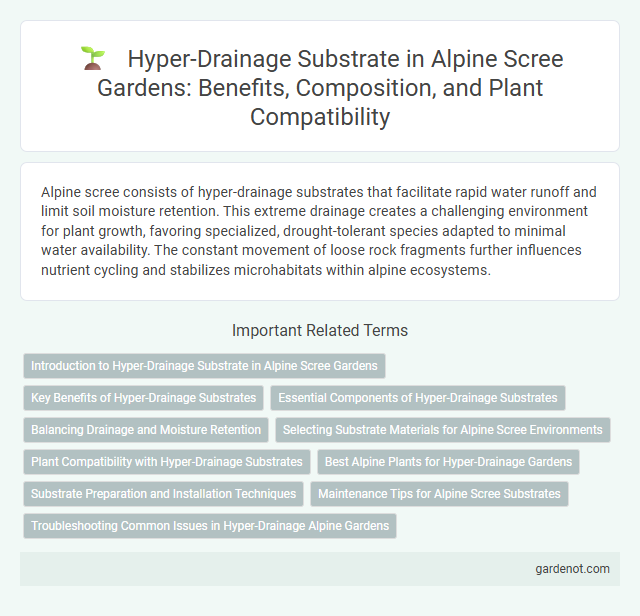Alpine scree consists of hyper-drainage substrates that facilitate rapid water runoff and limit soil moisture retention. This extreme drainage creates a challenging environment for plant growth, favoring specialized, drought-tolerant species adapted to minimal water availability. The constant movement of loose rock fragments further influences nutrient cycling and stabilizes microhabitats within alpine ecosystems.
Introduction to Hyper-Drainage Substrate in Alpine Scree Gardens
Hyper-drainage substrate in alpine scree gardens mimics the natural rocky and porous soil conditions found in high-altitude environments, promoting rapid water runoff and preventing root rot in delicate alpine plants. This substrate typically consists of a blend of coarse sand, gravel, and crushed rock, which ensures excellent aeration and nutrient availability while maintaining minimal moisture retention. Using hyper-drainage substrates supports the growth and resilience of drought-tolerant alpine species by replicating their native rocky habitats.
Key Benefits of Hyper-Drainage Substrates
Hyper-drainage substrates in alpine scree environments enhance water runoff, reducing soil saturation and preventing root rot. These substrates improve aeration, promoting healthy root development and increasing plant resilience in harsh, well-drained conditions. Their lightweight composition supports rapid drainage while retaining essential nutrients for alpine vegetation growth.
Essential Components of Hyper-Drainage Substrates
Hyper-drainage substrates in alpine scree consist primarily of coarse, angular rock fragments that prevent water retention and promote rapid drainage, essential for preventing soil saturation and supporting specialized plant adaptations. Key components include high porosity materials like gravel and broken rock, minimal fine particles to avoid clogging pore spaces, and an open, unstable matrix facilitating water flow while enabling root penetration. These characteristics maintain oxygen-rich conditions and reduce microbial decomposition, fostering unique vegetation resilient to drought and nutrient-poor environments.
Balancing Drainage and Moisture Retention
Alpine scree with a hyper-drainage substrate requires careful balancing of drainage and moisture retention to support plant life in its extreme environment. The coarse, granular composition facilitates rapid water runoff, reducing waterlogging risk but necessitating adaptations for moisture conservation within root zones. Vegetation in these areas often develops deep or extensive root systems and employs physiological mechanisms to maximize water uptake despite swift drainage rates.
Selecting Substrate Materials for Alpine Scree Environments
Selecting substrate materials for alpine scree environments requires prioritizing hyper-drainage properties to prevent waterlogging and promote root aeration. Coarse, well-graded gravels and angular rock fragments with high porosity enhance drainage efficiency, replicating natural scree conditions. Incorporating mineral substrates with low organic content ensures stability and resilience against freeze-thaw cycles common in alpine zones.
Plant Compatibility with Hyper-Drainage Substrates
Hyper-drainage substrates in alpine scree offer excellent water runoff, making them ideal for drought-tolerant, deep-rooting plants such as Sedum, Saxifraga, and Dryas species. These substrates prevent waterlogging while promoting aeration, essential for alpine plants adapted to well-drained, nutrient-poor conditions. Compatibility with hyper-drainage substrates supports root health and enhances plant resilience in extreme mountain environments.
Best Alpine Plants for Hyper-Drainage Gardens
Best alpine plants for hyper-drainage gardens thrive in well-drained, rocky scree environments typical of high-altitude terrains. Species such as Saxifraga, Androsace, and Sedum excel in rapid water runoff conditions due to their deep root systems and drought tolerance. These plants adapt to nutrient-poor, acidic substrates while maintaining vibrant growth and flowering in harsh alpine scree landscapes.
Substrate Preparation and Installation Techniques
Hyper-drainage substrates in alpine scree environments require precise substrate preparation to ensure rapid water infiltration and prevent root waterlogging. Installation techniques involve layering coarse gravel and angular rock fragments with graded particle sizes to maximize porosity and stability. Proper compaction methods must be employed to avoid substrate settling while maintaining essential void spaces for optimal drainage performance.
Maintenance Tips for Alpine Scree Substrates
Maintaining hyper-drainage substrates in alpine scree involves regularly monitoring soil moisture levels to prevent over-drying, which can stress native plants adapted to these environments. Incorporating coarse, angular materials such as gravel and sand enhances drainage and reduces compaction, promoting root aeration essential for alpine flora. Periodic removal of organic debris prevents nutrient buildup and supports the substrate's specialized, low-nutrient conditions crucial for alpine scree ecosystems.
Troubleshooting Common Issues in Hyper-Drainage Alpine Gardens
Hyper-drainage substrates in alpine scree gardens often face challenges like nutrient leaching and excessive drying, which can hinder plant establishment and growth. To troubleshoot these issues, amending the substrate with organic matter or adding moisture-retentive materials such as fine-grained sand or peat can improve water retention without compromising drainage. Monitoring soil moisture levels regularly and adjusting irrigation schedules are critical to maintaining optimal conditions for alpine species adapted to hyper-drainage environments.
Hyper-drainage substrate Infographic

 gardenot.com
gardenot.com